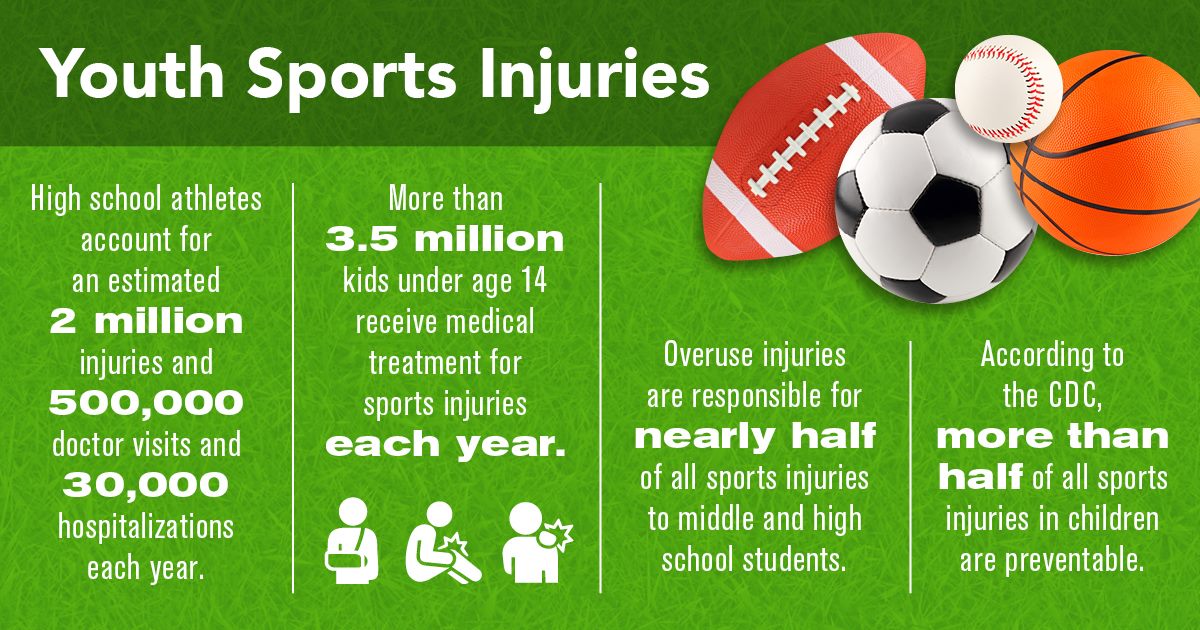In recent years, more and more kids are playing a single sport year-round. Is it to better their skill set? Of course, it is! Anyone who has played a sport or performed an activity at a high level of skill knows that repetition is critical to improvement. But what are the costs of giving up playing multiple sports in favor of focusing on a single athletic endeavor? We need look intensively at injury prevention for young athletes.

Though the “change of pace” is nice to give kids a variety of activities, the systemic problems lie much deeper. In outpatient orthopedics, we have seen a tremendous spike in repetitive overuse injuries. This spike has shown a direct correlation with the advent of the single sport athlete.
Where young athletes would get a change from the overhead throwing of baseball to the lower body taxation of soccer, we now see the continual repetition creating dysfunction in athletes who are not physically developed enough to withstand the rigors of a single sport year- round.
(KEEP OUR KIDS FROM GETTING HURT: SHOULD YOU GET YOUR CHILD A PRESEASON MOVEMENT SCREEN? CLICK HERE TO LEARN MORE!)
 Repetitive and overuse injuries can occur throughout the body for a very wide range of reasons. However, with our young athletes, problems such as rotator cuff injuries, hip flexor and Achilles tendinitis, and spinal pain are becoming overwhelmingly common.
Repetitive and overuse injuries can occur throughout the body for a very wide range of reasons. However, with our young athletes, problems such as rotator cuff injuries, hip flexor and Achilles tendinitis, and spinal pain are becoming overwhelmingly common.
The answer to why is simple: Over development of very specific muscle groups used in one sport; and under development of muscles utilized in multiple sports. These muscles would otherwise be strengthened and supported through different types isolation and combined movement patterns in different sports.
Variation of exercise is a fundamental principle that extends into simple weight training, up through differentiation in sporting activities. Cross training across athletic lines creates versatility in a young athlete’s ability to get stronger and remain healthy.
A 2018 review in the journal Pediatrics that summarized this research concluded that highly specialized athletes are nearly twice as likely to suffer an overuse injury as athletes who don’t specialize.
Take an overhead throwing athlete such as a baseball player. Conventional wisdom would say in order to throw the ball harder, strengthen the arm and in particularly the rotator cuff. But if you delve deeper into the mechanics behind a throwing athlete, we realize that core stability and lower body strength play an equally large role.

Core and leg strength generates biomechanical power to improve distance and velocity with throws. Whether pitching or making the throw from 3rd to 1st base when younger baseball players make the transition to the big field. Without proper lower body strength and a strong core, a player is forced to rely solely on creating power from their arm, hence creating a tremendous strain on their shoulder and elbow.


In the rehabilitation setting, we offset these issues by strengthening the under developed muscles. This is necessary to support areas susceptible to overuse injuries, and improve range of motion otherwise limited due to using only a few select movement patterns while playing a lone sport.
When assessing running athletes who compete in cross country and track and field events, we commonly find weakness moving in lateral and rotational directions. By observing what their sport requires, it is straight line movement forward. Most injuries in running athletes have a deeply rooted cause in a lack of hip abduction (lateral) and rotational control.
Understanding the demands of a single sport athlete and the likely dominance and weakness of respective muscle groups can play a tremendous role in keeping our athletes healthy and on the field. However, this will only occur if we take a proactive approach to having our athletes screened in before and after their seasons to ensure proper muscle performance.
As AAU, travel teams, and the various town leagues can dominate a schedule, it leaves little precious time for other athletic endeavors. But let’s not forget a basic principle of athletics: the stronger you are throughout your body, the better you will perform, and the less likely you are to sustain injuries.
Kyle Branday, MSPT, C-PS, is a licensed Physical Therapist and is the supervisor of the Woodbridge office. He is a graduate of Quinnipiac University where he earned his Master’s degree in Physical Therapy. In addition, Kyle is Level 2 Certified by the Institute of Advanced Musculoskeletal Treatment for Dry Needling. Kyle enjoys treating patients with a wide range of orthopedic and neurological conditions.
Kyle has extensive training in the diagnosis and treatment of acute and chronic orthopedic and sports injuries, neurological rehabilitation, manual therapy, sports specific training, Selective Functional Movement Assessment (SFMA) and works with patients ranging from pediatrics to geriatrics.
Recently, he has completed course work to earn designation as a Champion Performance Specialist (C-PS) to enhance his work with elite athletes and weekend warriors alike. Kyle is an avid sports fan and works with our patients in our Sports Performance Programs.
Tags:
- Baseball
- Basketball
- Football
- Injury Prevention
- Mechanics
- multisport athletes
- Orthopedics
- overuse
- physical therapy
- Physiotherapy
- PT
- Single Sport
- Soccer
- sports
- sports injuries
- Track
- Youth Athletes

